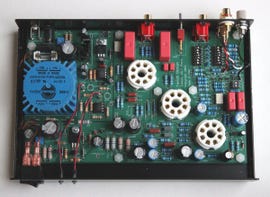Scott Reynolds founded Tavish Design in 2011 to follow his bliss. He holds a Ph.D. in electrical engineering, works for IBM, and authored over 30 patents. He may be a whiz with digital tech, but when it comes to listening to music Reynolds prefers the sound of tube electronics over solid-state and LPs over digital. That’s why he designed a tube phono preamplifier first for his home system, then he made a few more for friends, and that eventually led to going into business. He now offers a range of affordable (by audiophile standards) tube electronics. Reynolds and his son hand-craft Tavish Design components in Amawalk, New York.

The Tavish Design Vintage 6SL7 phono preamplifier
Tavish Design
I met Reynolds at a friend’s home a few months ago and expressed an interest in reviewing his newest design, the Vintage 6SL7 phono preamplifier. It’s compatible with moving-coil and moving-magnet cartridges. I used an Ortofon Cadenza Black moving-coil cartridge that’s mounted on my VPI Classic turntable for all of my listening tests.
The Vintage 6SL7 uses three 6SL7GT tubes, a vacuum tube that was introduced by RCA in 1941 and still finds favor with audiophile designers today. (Don’t worry, it’s still being manufactured.) When used with moving-magnet cartridges, the Vintage 6SL7’s circuitry is all-tube; with moving-coil cartridges, an onboard JFET (solid-state) preamplifier is used with the tubes.
The aluminum chassis measures 9 by 6 by 1.5 inches, and there’s a separate wall-wart power transformer. You’ll need to remove four chassis screws to gain access to the internal impedance switches to match the Vintage 6SL7 to your phono cartridge; for me, the whole setup took about five minutes. With the cover off I admired Reynolds’ handiwork — the Vintage 6SL7’s build quality is neat and clean.


The Tavish Design Vintage 6SL7 phono preamplifier interior, shown without tubes installed.
Tavish Design
It may be a tube design, but it didn’t sound overly sweet or romantic until I compared it with a solid-state phono preamplifier, the Lehmann Black Cube SE II ($1,149). The Vintage 6SL7’s sound was softer, and more laid-back. I like both preamps a lot, but I have to admit the Vintage 6SL7’s superior soundstage depth appealed to me. Bass definition was the same between the two preamps, but the Vintage 6SL7 had more bass. I noted the Black Cube SE II’s soundstage was flatter, the Vintage 6SL7’s was bigger and more three-dimensional.
Switching back and forth between the two amps, the Black Cube SEII phono preamp was more transparent and clear than the Vintage 6SL7, and I would guess it’s more accurate overall. Jazz legend Thelonious Monk’s “Monk’s Dream” is an LP I’ve played countless times, but with the Vintage 6SL7 Monk’s swinging big band swung harder than I’m used to. The recording felt more alive, more energized than usual — the Vintage 6SL7 set the music free.
Brian Eno’s ambient classic “Music For Films” LP unfurled a huge soundstage that set up residence in my listening room. The mix of acoustic and electronic sounds comingled in free space, floating free of my Zu Druid V speakers.
To finish I compared the Vintage 6SL7 with another solid-state amp, the Parasound Halo JC-3+ ($2,995). The Vintage 6SL7 produced a bigger, more “holographic” soundstage, but the JC-3+ was more dynamically alive, and its bass went deeper and was better defined. I will have more to say about the Halo JC-3+ in the coming months.
The Vintage 6SL7’s big draw has everything to do with the way it breathes life into recorded music, and at the end of the day that’s what really matters.
The Vintage 6SL7 is sold direct by Tavish Design for $549 with a 30-day return policy and a six-year warranty. The Vintage 6SL7 is also available as a kit for $399; Tavish has four other products currently listed on its website.




